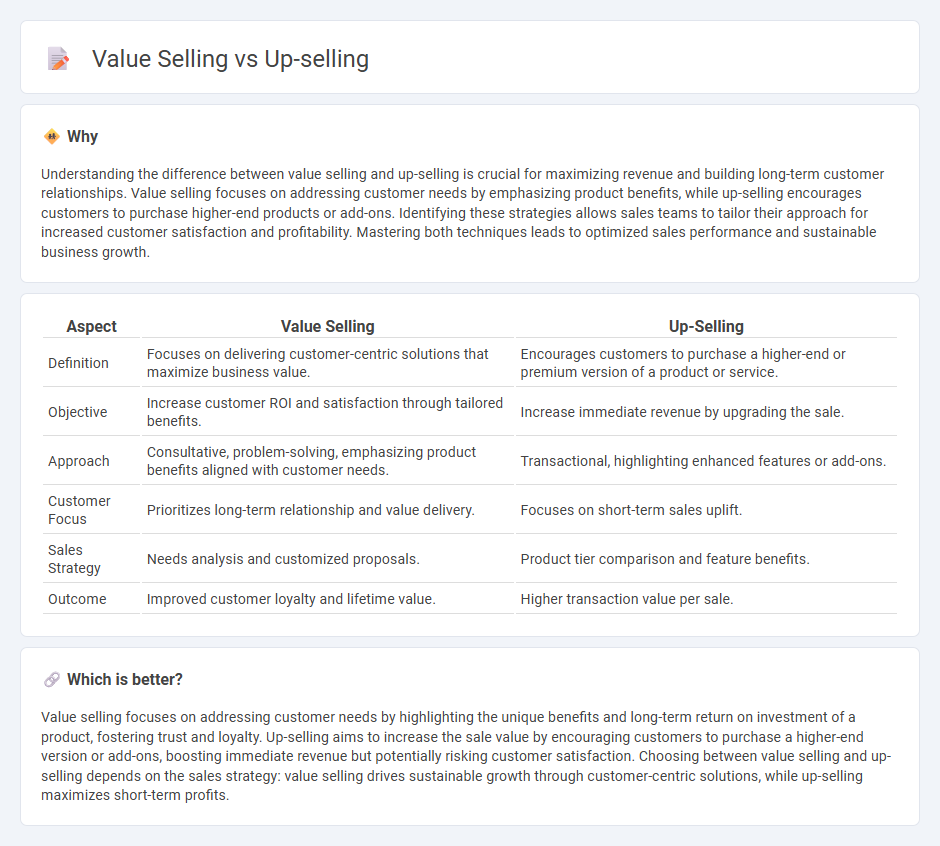
Value selling focuses on demonstrating the unique benefits and ROI a product or service provides to meet the customer's specific needs, enhancing satisfaction and long-term loyalty. Up-selling aims to increase transaction size by encouraging customers to purchase higher-end or additional products, boosting immediate revenue. Discover more about how each strategy can optimize your sales performance.
Why it is important
Understanding the difference between value selling and up-selling is crucial for maximizing revenue and building long-term customer relationships. Value selling focuses on addressing customer needs by emphasizing product benefits, while up-selling encourages customers to purchase higher-end products or add-ons. Identifying these strategies allows sales teams to tailor their approach for increased customer satisfaction and profitability. Mastering both techniques leads to optimized sales performance and sustainable business growth.
Comparison Table
| Aspect | Value Selling | Up-Selling |
|---|---|---|
| Definition | Focuses on delivering customer-centric solutions that maximize business value. | Encourages customers to purchase a higher-end or premium version of a product or service. |
| Objective | Increase customer ROI and satisfaction through tailored benefits. | Increase immediate revenue by upgrading the sale. |
| Approach | Consultative, problem-solving, emphasizing product benefits aligned with customer needs. | Transactional, highlighting enhanced features or add-ons. |
| Customer Focus | Prioritizes long-term relationship and value delivery. | Focuses on short-term sales uplift. |
| Sales Strategy | Needs analysis and customized proposals. | Product tier comparison and feature benefits. |
| Outcome | Improved customer loyalty and lifetime value. | Higher transaction value per sale. |
Which is better?
Value selling focuses on addressing customer needs by highlighting the unique benefits and long-term return on investment of a product, fostering trust and loyalty. Up-selling aims to increase the sale value by encouraging customers to purchase a higher-end version or add-ons, boosting immediate revenue but potentially risking customer satisfaction. Choosing between value selling and up-selling depends on the sales strategy: value selling drives sustainable growth through customer-centric solutions, while up-selling maximizes short-term profits.
Connection
Value selling enhances customer focus by emphasizing the benefits and ROI of a product, creating trust that facilitates up-selling opportunities. Up-selling leverages the value proposition established through value selling to encourage customers to invest in higher-tier products or services. Both strategies aim to maximize revenue by aligning sales efforts with customer needs and perceived value.
Key Terms
Cross-Sell (up-selling)
Cross-selling emphasizes offering complementary products or services that enhance the primary purchase, increasing overall transaction value. Up-selling encourages customers to choose a higher-end version of the product or additional features, maximizing revenue per sale. Discover how mastering cross-selling techniques can drive sustainable growth and improve customer satisfaction.
Solution Benefits (value selling)
Value selling centers on highlighting the specific benefits and outcomes a solution delivers, ensuring customers understand its impact on their business goals and challenges. Up-selling emphasizes increasing purchase value by suggesting higher-end products or add-ons, often focusing on features rather than tailored benefits. Explore how shifting from product features to solution benefits can drive deeper customer engagement and long-term value creation.
Customer Needs
Up-selling emphasizes encouraging customers to purchase higher-end products or add-ons, often prioritizing increased transaction value over specific needs. Value selling centers on understanding and addressing customer needs by offering tailored solutions that deliver measurable benefits and long-term satisfaction. Explore how adopting value selling strategies can enhance customer loyalty and drive sustainable business growth.
Source and External Links
Upselling - Wikipedia - Upselling is a sales technique where a seller invites the customer to purchase more expensive items, upgrades, or other add-ons to increase revenue.
What Is Upselling? Definition, Examples, & Expert Tips - Plaky - Upselling involves offering a customer a higher-end or upgraded version of a product or service to make a more profitable sale and boost revenue.
What Is Upselling? Upselling Definition and Examples - Shopify - Upselling happens when a seller encourages a customer to buy a more expensive item, upgrade, or add-on with the aim of making a more profitable transaction.
 dowidth.com
dowidth.com